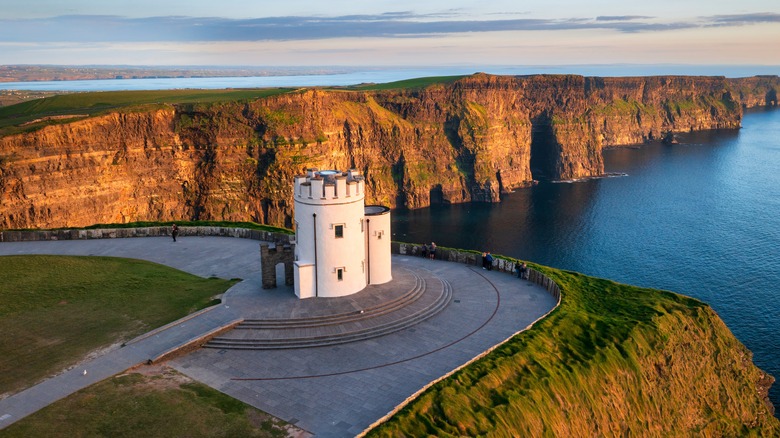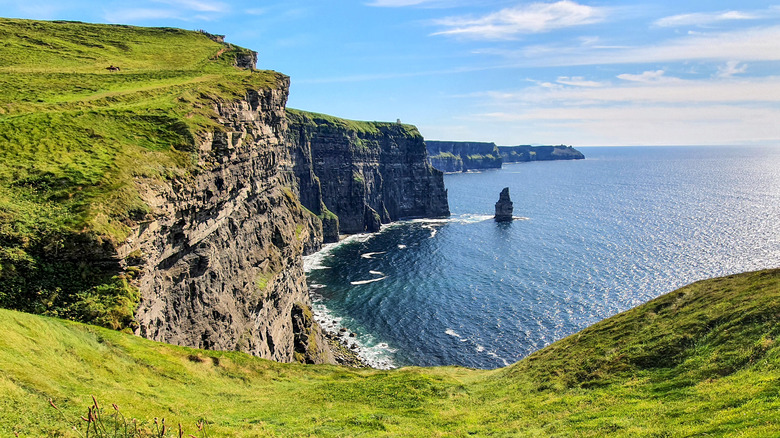One Of Ireland's Most Iconic Landmarks Is As Scenically Stunning As It Is Dangerous
The western shore of Ireland's County Clare ends in a ragged, 8-mile stretch of coastline that looks as if some giant sea monster has taken a bite out of it. An expanse of pool-table-felt green ends in a scalloped wall of golden limestone cliffs that, from an aerial view, look a lot like tooth marks. These are the Cliffs of Moher, which fall 700 feet straight down into the roiling Atlantic Ocean.
A million visitors per year come to this UNESCO Global Geopark that includes both the cliffs and the Burren, that rolling, green, fossil-rich landscape known for its farm bounty and wildflower displays. It's also known for its birdwatching, and the Visitor Center loans out binoculars so you can see the quirky, comical puffins waddle to and from their nests. That Visitor Center itself is an attraction, built partially underground, with a profile that blends seamlessly into the landscape. It's won multiple architectural awards.
Ireland is overall one of the safest, most welcoming European countries, but this ravishing landscape has a dark side. As beautiful as these cliffs are, they're also deadly. It is oh-so-very tempting to creep up and peer over the precipice, maybe capture a pic for your Instagram striking a yoga pose or doing a cartwheel. But there's a reason the cliffs' most popular viewing areas have fences: The crumbling cliff sides have claimed their share of lives. In the 25 years between 1992 and 2017, 66 people perished here, including 18 international tourists, some of whom were just looking to snap that perfect pic.
Visiting the Cliffs of Moher
In Ireland, you don't hike; you walk, or ramble. For the most thoroughly satisfying ramble along the cliffs, park in the quaint Irish town of Doolin, known for its cheerfully colored houses, welcoming pubs, and traditional Irish music. Hike from there to the Visitor's Center, then to Hag's Head, for a total of 8.7 miles. You'll drink in all the vistas on this route, which can be shortened by starting or ending at the Visitor's Center. Just mind the forecast, as the blustery, whipping winds can be strong enough to knock you off your feet — another reason to stick to the trail well away from the edge. The wildness of this rugged, uncompromising landscape resembles California's Lost Coast, but without the remoteness — and with the promise of a warm Irish hearth waiting for you at the end.
This trail will take in all the observation points. For a bird's eye view, you can climb the 1835 O'Brien's Tower, a crenelated observation deck surrounded by graceful paved pathways. Walk one way, then take a bus or taxi back to warm yourself up with a pint of Guinness at Gus O'Connor's Pub; if you're lucky, a one-legged Irish fisherman might serenade you with bawdy songs. You'll find that the rumor is true: The Guinness in Ireland really does taste amazing poured from an Irish tap.
More ways to explore the Cliffs of Moher
Once you've walked the cliffs, you can see the same view from a different angle by taking a tour of the cliffs on the Doolin Ferry. This will get you closer to the seabird colonies on the isolated rock outcropping known as the Sea Stack, and take you past the sea caves where scenes from "Harry Potter and the Half-Blood Prince" were filmed. The same ferry system can take you past the cliffs and over to the Aran Isles. If you're a fan of "The Banshees of Inisherin," the Golden Globe-winning and Oscar-nominated film starring Colin Farrell, you'll recognize some of the island's iconic scenery. While the movie's isle of Inisherin is entirely fictional, some of the film was shot here on the island of Inishmore.
"There's a stark beauty about these blustery islands and the simple lives its inhabitants eke out of a few inches of topsoil and a mean sea," Rick Steves wrote of the Aran Islands, calling them "bleak and beautiful." No wonder one of the main tourist attractions here is the Aran Sweater Market, where you can buy yourself a chunky wool cable knit to guard against the biting chill on the ferry ride back. The Cliffs of Moher lie along the Wild Atlantic Way, a 1,600-mile route along Ireland's west coast, so you can make this into an epic Irish road trip. If you continue south from the Cliffs, you can make your next stop Dingle, Rick Steves' favorite Irish town, for even more Irish pub music and merriment.


